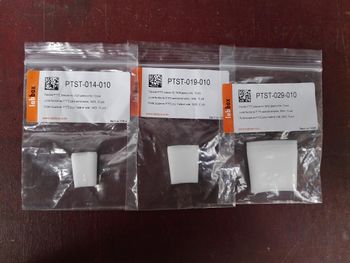Difference between revisions of "Joint sleeve"
(Created page with "{{Stub}} A '''joint sleeve''' is a PTFE sleeve used to seal ground glass joints in processes where the reagents can attack silicone grease. ==...") |
|||
| (6 intermediate revisions by the same user not shown) | |||
| Line 1: | Line 1: | ||
{{Stub}} | {{Stub}} | ||
| − | A '''joint sleeve''' is a [[Polytetrafluoroethylene|PTFE]] sleeve used to seal ground glass joints in processes where the reagents can attack [[silicone grease]]. | + | [[File:PTFE joint sleeves.jpg|thumb|350px|PTFE joint sleeves for 14/23, 19/26 and 29/32 joints]] |
| + | A '''joint sleeve''' is a [[Polytetrafluoroethylene|PTFE]] sleeve used to seal ground glass joints in processes where the reagents can attack [[silicone grease]], such as distillation of [[nitric acid]]. | ||
==General== | ==General== | ||
| − | PTFE joint sleeves are conical sheets of PTFE, which come in two versions: rigid and flexible. The rigid sleeve is thick, while the flexible one is thinner and can be deformed by hand. While the thinner ones are often preferred, they are also easier to damage. | + | PTFE joint sleeves are hollow conical frustum-shaped sheets of PTFE, which come in two versions: rigid and flexible. The rigid sleeve is thick, while the flexible one is thinner and can be deformed by hand. While the thinner ones are often preferred, they are also easier to damage. PTFE joint sleeves can handle temperatures up to 280 °C. |
==Availability== | ==Availability== | ||
| − | PTFE joint sleeves can be purchased from lab suppliers, though they | + | PTFE joint sleeves can be purchased from lab suppliers, though they are a bit pricey. Usually they're sold in packs of 10. |
==DIY joint sleeve== | ==DIY joint sleeve== | ||
You can make your own joint sleeves by carefully cutting a Teflon sheet in the form of a cone frustum projection, then carefully attach it to the male ground glass joint, before carefully placing it in the female ground glass joint. If your PTFE sheet gets wrinkled, it may not seal properly. | You can make your own joint sleeves by carefully cutting a Teflon sheet in the form of a cone frustum projection, then carefully attach it to the male ground glass joint, before carefully placing it in the female ground glass joint. If your PTFE sheet gets wrinkled, it may not seal properly. | ||
| + | |||
| + | ==Projects== | ||
| + | *When using a [[Adapter#Pouring_adapter|pouring adapter]], a PTFE joint sleeve is better than grease | ||
| + | *Distillation of [[nitric acid]] | ||
| + | |||
| + | ==See also== | ||
| + | *[[Ground glass joint]] | ||
| + | *[[Silicone grease]] | ||
==References== | ==References== | ||
| Line 16: | Line 25: | ||
*[http://www.sciencemadness.org/talk/viewthread.php?tid=12311 PTFE joint sleeves] | *[http://www.sciencemadness.org/talk/viewthread.php?tid=12311 PTFE joint sleeves] | ||
*[http://www.sciencemadness.org/talk/viewthread.php?tid=16519 glass joint sealer?] | *[http://www.sciencemadness.org/talk/viewthread.php?tid=16519 glass joint sealer?] | ||
| + | *[http://www.sciencemadness.org/talk/viewthread.php?tid=82747 Where can you purchase teflon sleeves/cuffs?] | ||
[[Category:Lab equipment]] | [[Category:Lab equipment]] | ||
[[Category:Plasticware]] | [[Category:Plasticware]] | ||
Latest revision as of 21:35, 30 April 2020
 |
This article is a stub. Please help Sciencemadness Wiki by expanding it, adding pictures, and improving existing text.
|
A joint sleeve is a PTFE sleeve used to seal ground glass joints in processes where the reagents can attack silicone grease, such as distillation of nitric acid.
Contents
General
PTFE joint sleeves are hollow conical frustum-shaped sheets of PTFE, which come in two versions: rigid and flexible. The rigid sleeve is thick, while the flexible one is thinner and can be deformed by hand. While the thinner ones are often preferred, they are also easier to damage. PTFE joint sleeves can handle temperatures up to 280 °C.
Availability
PTFE joint sleeves can be purchased from lab suppliers, though they are a bit pricey. Usually they're sold in packs of 10.
DIY joint sleeve
You can make your own joint sleeves by carefully cutting a Teflon sheet in the form of a cone frustum projection, then carefully attach it to the male ground glass joint, before carefully placing it in the female ground glass joint. If your PTFE sheet gets wrinkled, it may not seal properly.
Projects
- When using a pouring adapter, a PTFE joint sleeve is better than grease
- Distillation of nitric acid
